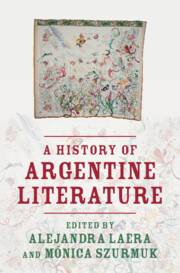Book contents
- A History of Argentine Literature
- A History of Argentine Literature
- Copyright page
- Contents
- Figures
- Contributors
- Editors’ Acknowledgments
- Introduction
- Part I Literary Dates
- Part II Critical Inroads
- Chapter 11 Print Culture in the Nineteenth Century
- Chapter 12 Criollismo: Gauchos in Literature and Film
- Chapter 13 Race and Nation
- Chapter 14 Science in Argentine Literature
- Chapter 15 Essay and Territory: The Geography of National Identity
- Chapter 16 Music as Sonic Literature
- Chapter 17 The Jewish Presence in Argentine Literature
- Chapter 18 Emancipation: Twentieth-Century Female Writers, Journalists, and Activists
- Chapter 19 Forsaking Tradition: Dislocating the Sovereignty of Argentine Literature
- Chapter 20 Mujeres raras: Patriarchal Nightmares, Dissident Imagination
- Part III Literary Names
- Index
- References
Chapter 15 - Essay and Territory: The Geography of National Identity
from Part II - Critical Inroads
Published online by Cambridge University Press: 09 May 2024
- A History of Argentine Literature
- A History of Argentine Literature
- Copyright page
- Contents
- Figures
- Contributors
- Editors’ Acknowledgments
- Introduction
- Part I Literary Dates
- Part II Critical Inroads
- Chapter 11 Print Culture in the Nineteenth Century
- Chapter 12 Criollismo: Gauchos in Literature and Film
- Chapter 13 Race and Nation
- Chapter 14 Science in Argentine Literature
- Chapter 15 Essay and Territory: The Geography of National Identity
- Chapter 16 Music as Sonic Literature
- Chapter 17 The Jewish Presence in Argentine Literature
- Chapter 18 Emancipation: Twentieth-Century Female Writers, Journalists, and Activists
- Chapter 19 Forsaking Tradition: Dislocating the Sovereignty of Argentine Literature
- Chapter 20 Mujeres raras: Patriarchal Nightmares, Dissident Imagination
- Part III Literary Names
- Index
- References
Summary
“The evil of the Argentine Republic is its extension”: Domingo Faustino Sarmiento´s famous admonition in Facundo (1845) was not only a program for the modernization of Argentina but a figurative horizon for the literary genre that was going to critically analyze that very modernization until the mid-twentieth century: the “national character essay.” This genre had analogous developments in many parts of Latin America, but did not establish the link between territory and national identity as strongly as it did in Argentina. In the century that leads from Sarmiento to Ezequiel Martínez Estrada the genre displays a series of literary resources that seek to take the geographical configuration of the country as a measure of its people’s soul. This can be seen both in the invention of a physical sphere of the nation to set the stage for his political drama (Sarmiento) and in the metaphorization of the map as the nation’s body (Martínez Estrada). This corpus is analyzed here in relation to real and imaginary geographies that produced it and were produced by it.
Keywords
- Type
- Chapter
- Information
- A History of Argentine Literature , pp. 232 - 244Publisher: Cambridge University PressPrint publication year: 2024



